Search
- Page Path
- HOME > Search
- Calcium & bone metabolism
- Bone Loss after Solid Organ Transplantation: A Review of Organ-Specific Considerations
- Kyoung Jin Kim, Jeonghoon Ha, Sang Wan Kim, Jung-Eun Kim, Sihoon Lee, Han Seok Choi, Namki Hong, Sung Hye Kong, Seong Hee Ahn, So Young Park, Ki-Hyun Baek, on Behalf of Metabolic Bone Disease Study Group of Korean Endocrine Society
- Endocrinol Metab. 2024;39(2):267-282. Published online April 25, 2024
- DOI: https://doi.org/10.3803/EnM.2024.1939
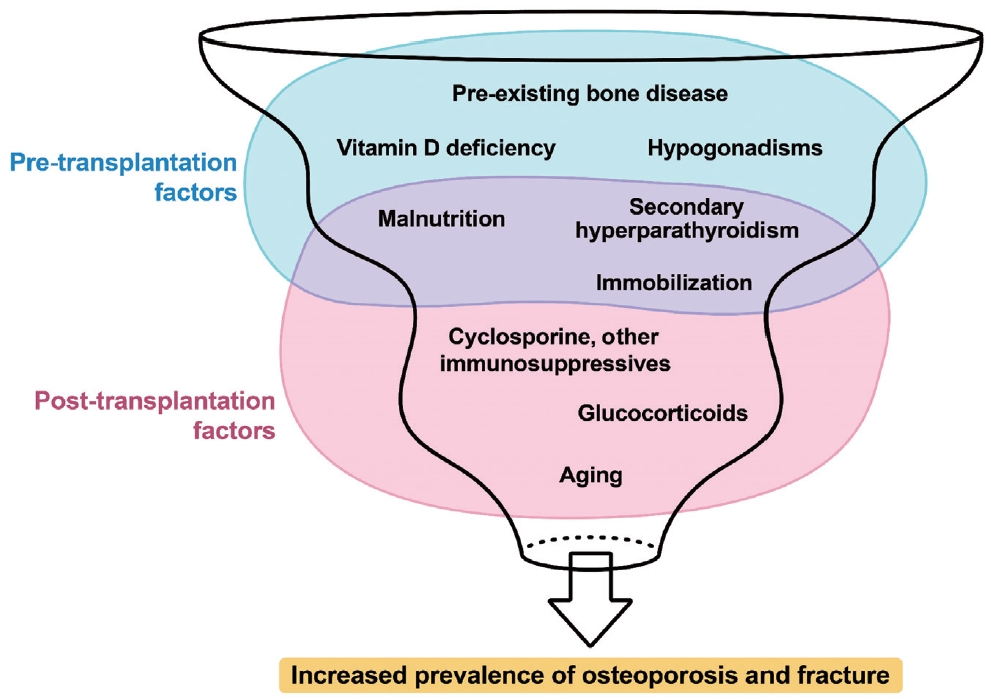
- 238 View
- 12 Download
-
 Abstract
Abstract
 PDF
PDF PubReader
PubReader  ePub
ePub - This review article investigates solid organ transplantation-induced osteoporosis, a critical yet often overlooked issue, emphasizing its significance in post-transplant care. The initial sections provide a comprehensive understanding of the prevalence and multifactorial pathogenesis of transplantation osteoporosis, including factors such as deteriorating post-transplantation health, hormonal changes, and the impact of immunosuppressive medications. Furthermore, the review is dedicated to organ-specific considerations in transplantation osteoporosis, with separate analyses for kidney, liver, heart, and lung transplantations. Each section elucidates the unique challenges and management strategies pertinent to transplantation osteoporosis in relation to each organ type, highlighting the necessity of an organ-specific approach to fully understand the diverse manifestations and implications of transplantation osteoporosis. This review underscores the importance of this topic in transplant medicine, aiming to enhance awareness and knowledge among clinicians and researchers. By comprehensively examining transplantation osteoporosis, this study contributes to the development of improved management and care strategies, ultimately leading to improved patient outcomes in this vulnerable group. This detailed review serves as an essential resource for those involved in the complex multidisciplinary care of transplant recipients.

- Adrenal gland
- 2023 Korean Endocrine Society Consensus Guidelines for the Diagnosis and Management of Primary Aldosteronism
- Jeonghoon Ha, Jung Hwan Park, Kyoung Jin Kim, Jung Hee Kim, Kyong Yeun Jung, Jeongmin Lee, Jong Han Choi, Seung Hun Lee, Namki Hong, Jung Soo Lim, Byung Kwan Park, Jung-Han Kim, Kyeong Cheon Jung, Jooyoung Cho, Mi-kyung Kim, Choon Hee Chung, The Committee of Clinical Practice Guideline of Korean Endocrine Society, The Korean Adrenal Study Group of Korean Endocrine Society
- Endocrinol Metab. 2023;38(6):597-618. Published online October 13, 2023
- DOI: https://doi.org/10.3803/EnM.2023.1789
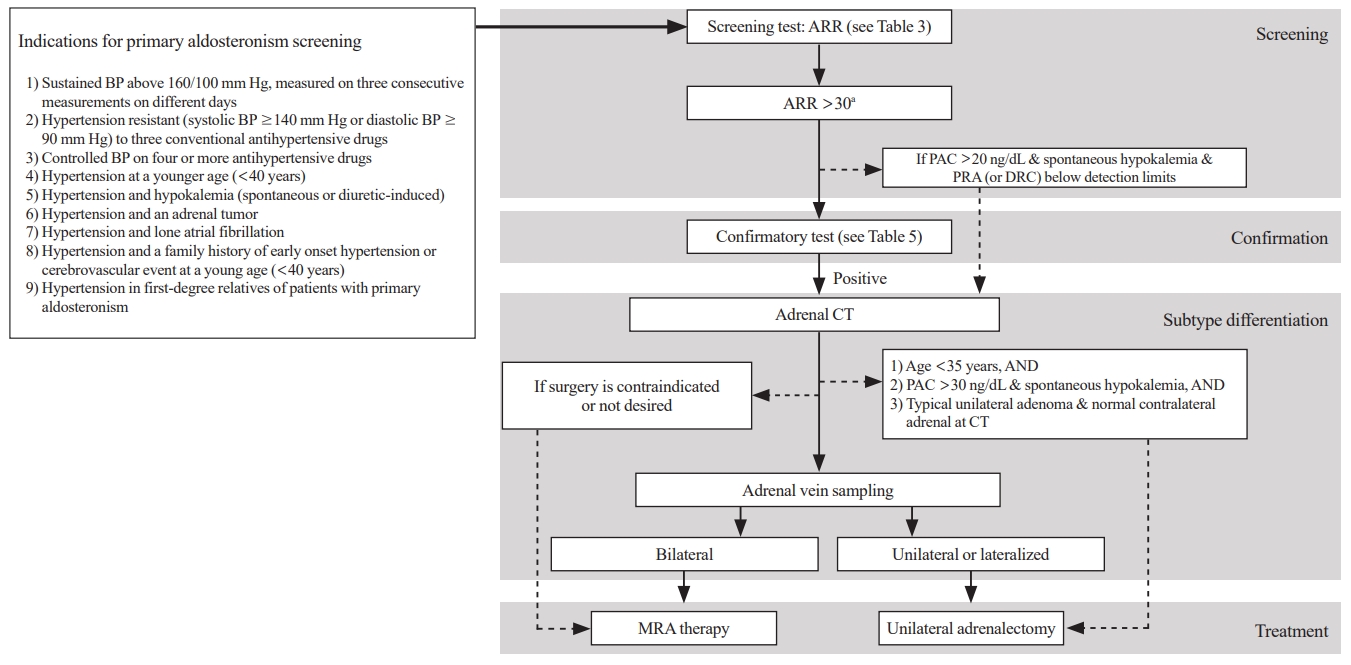
- 3,524 View
- 489 Download
- 1 Web of Science
- 1 Crossref
-
 Abstract
Abstract
 PDF
PDF PubReader
PubReader  ePub
ePub - Primary aldosteronism (PA) is a common, yet underdiagnosed cause of secondary hypertension. It is characterized by an overproduction of aldosterone, leading to hypertension and/or hypokalemia. Despite affecting between 5.9% and 34% of patients with hypertension, PA is frequently missed due to a lack of clinical awareness and systematic screening, which can result in significant cardiovascular complications. To address this, medical societies have developed clinical practice guidelines to improve the management of hypertension and PA. The Korean Endocrine Society, drawing on a wealth of research, has formulated new guidelines for PA. A task force has been established to prepare PA guidelines, which encompass epidemiology, pathophysiology, clinical presentation, diagnosis, treatment, and follow-up care. The Korean clinical guidelines for PA aim to deliver an evidence-based protocol for PA diagnosis, treatment, and patient monitoring. These guidelines are anticipated to ease the burden of this potentially curable condition.
-
Citations
Citations to this article as recorded by- Correlation of Histopathologic Subtypes of Primary Aldosteronism with Clinical Phenotypes and Postsurgical Outcomes
Chang Ho Ahn, You-Bin Lee, Jae Hyeon Kim, Young Lyun Oh, Jung Hee Kim, Kyeong Cheon Jung
The Journal of Clinical Endocrinology & Metabolism.2023;[Epub] CrossRef
- Correlation of Histopathologic Subtypes of Primary Aldosteronism with Clinical Phenotypes and Postsurgical Outcomes

- Diabetes, Obesity and Metabolism
- Identification of Healthy and Unhealthy Lifestyles by a Wearable Activity Tracker in Type 2 Diabetes: A Machine Learning-Based Analysis
- Kyoung Jin Kim, Jung-Been Lee, Jimi Choi, Ju Yeon Seo, Ji Won Yeom, Chul-Hyun Cho, Jae Hyun Bae, Sin Gon Kim, Heon-Jeong Lee, Nam Hoon Kim
- Endocrinol Metab. 2022;37(3):547-551. Published online June 29, 2022
- DOI: https://doi.org/10.3803/EnM.2022.1479
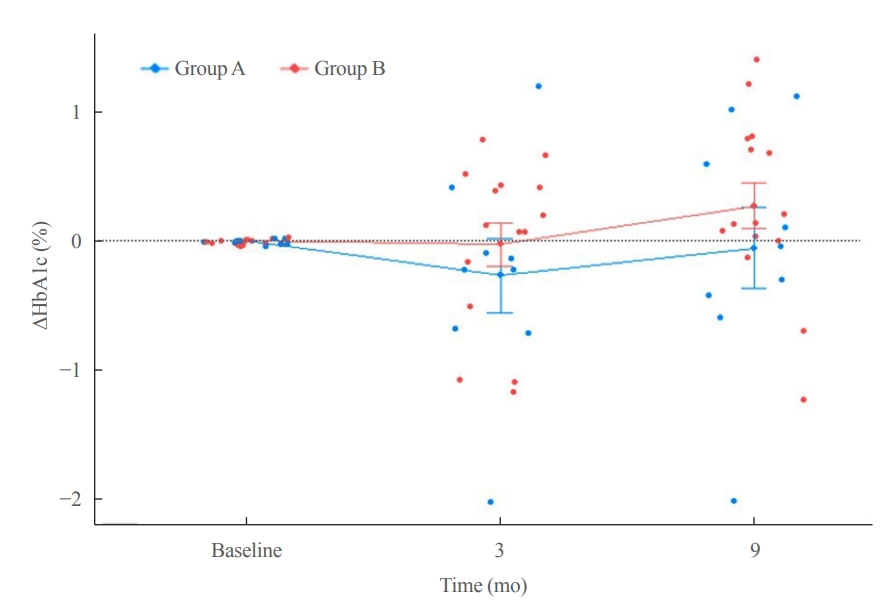
- 2,978 View
- 125 Download
- 2 Web of Science
- 2 Crossref
-
 Abstract
Abstract
 PDF
PDF Supplementary Material
Supplementary Material PubReader
PubReader  ePub
ePub - Lifestyle is a critical aspect of diabetes management. We aimed to define a healthy lifestyle using objectively measured parameters obtained from a wearable activity tracker (Fitbit) in patients with type 2 diabetes. This prospective observational study included 24 patients (mean age, 46.8 years) with type 2 diabetes. Expectation–maximization clustering analysis produced two groups: A (n=9) and B (n=15). Group A had a higher daily step count, lower resting heart rate, longer sleep duration, and lower mean time differences in going to sleep and waking up than group B. A Shapley additive explanation summary analysis indicated that sleep-related factors were key elements for clustering. The mean hemoglobin A1c level was 0.3 percentage points lower at the end of follow-up in group A than in group B. Factors related to regular sleep patterns could be possible determinants of lifestyle clustering in patients with type 2 diabetes.
-
Citations
Citations to this article as recorded by- Rethink nutritional management in chronic kidney disease care
Fangyue Chen, Krit Pongpirul
Frontiers in Nephrology.2023;[Epub] CrossRef - Effect of a Wearable Device–Based Physical Activity Intervention in North Korean Refugees: Pilot Randomized Controlled Trial
Ji Yoon Kim, Kyoung Jin Kim, Kyeong Jin Kim, Jimi Choi, Jinhee Seo, Jung-Been Lee, Jae Hyun Bae, Nam Hoon Kim, Hee Young Kim, Soo-Kyung Lee, Sin Gon Kim
Journal of Medical Internet Research.2023; 25: e45975. CrossRef
- Rethink nutritional management in chronic kidney disease care

- Adrenal gland
- Diagnosis for Pheochromocytoma and Paraganglioma: A Joint Position Statement of the Korean Pheochromocytoma and Paraganglioma Task Force
- Eu Jeong Ku, Kyoung Jin Kim, Jung Hee Kim, Mi Kyung Kim, Chang Ho Ahn, Kyung Ae Lee, Seung Hun Lee, You-Bin Lee, Kyeong Hye Park, Yun Mi Choi, Namki Hong, A Ram Hong, Sang-Wook Kang, Byung Kwan Park, Moon-Woo Seong, Myungshin Kim, Kyeong Cheon Jung, Chan Kwon Jung, Young Seok Cho, Jin Chul Paeng, Jae Hyeon Kim, Ohk-Hyun Ryu, Yumie Rhee, Chong Hwa Kim, Eun Jig Lee
- Endocrinol Metab. 2021;36(2):322-338. Published online April 6, 2021
- DOI: https://doi.org/10.3803/EnM.2020.908
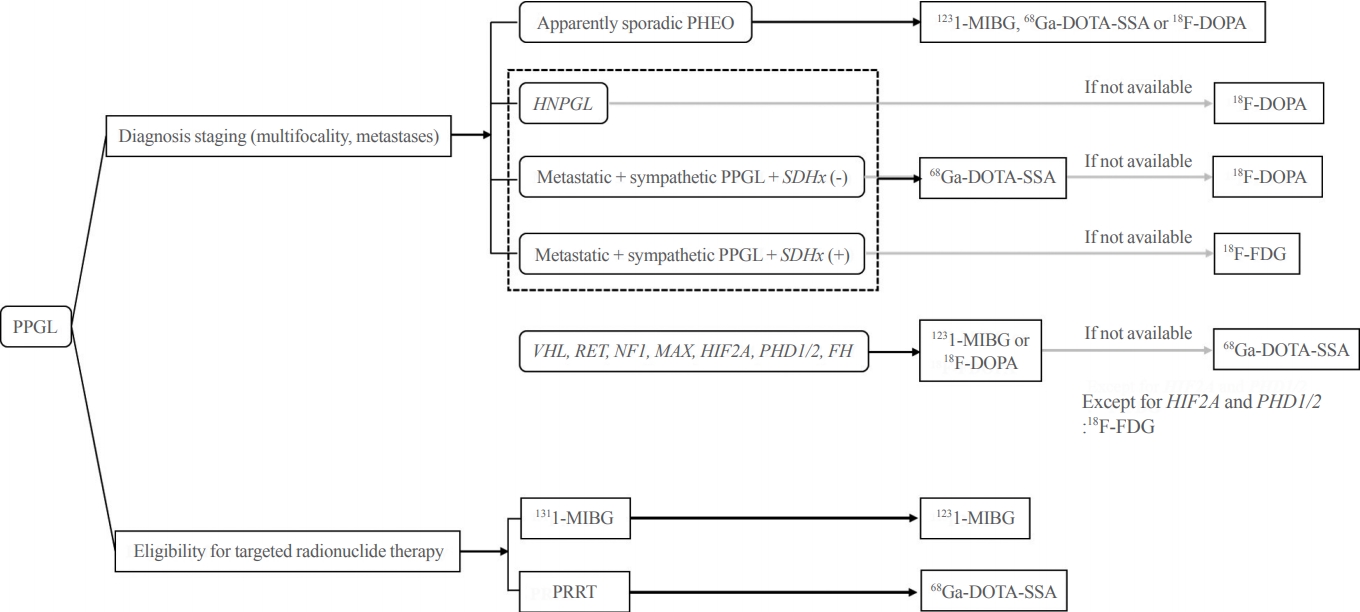
- 7,547 View
- 573 Download
- 9 Web of Science
- 11 Crossref
-
 Abstract
Abstract
 PDF
PDF PubReader
PubReader  ePub
ePub - Pheochromocytoma and paraganglioma (PPGLs) are rare catecholamine-secreting neuroendocrine tumors but can be life-threatening. Although most PPGLs are benign, approximately 10% have metastatic potential. Approximately 40% cases are reported as harboring germline mutations. Therefore, timely and accurate diagnosis of PPGLs is crucial. For more than 130 years, clinical, molecular, biochemical, radiological, and pathological investigations have been rapidly advanced in the field of PPGLs. However, performing diagnostic studies to localize lesions and detect metastatic potential can be still challenging and complicated. Furthermore, great progress on genetics has shifted the paradigm of genetic testing of PPGLs. The Korean PPGL task force team consisting of the Korean Endocrine Society, the Korean Surgical Society, the Korean Society of Nuclear Medicine, the Korean Society of Pathologists, and the Korean Society of Laboratory Medicine has developed this position statement focusing on the comprehensive and updated diagnosis for PPGLs.
-
Citations
Citations to this article as recorded by- A Prospective Comparative Study of 18F-FDOPA PET/CT Versus 123I-MIBG Scintigraphy With SPECT/CT for the Diagnosis of Pheochromocytoma and Paraganglioma
Changhwan Sung, Hyo Sang Lee, Dong Yun Lee, Yong-il Kim, Jae Eun Kim, Sang Ju Lee, Seung Jun Oh, Tae-Yon Sung, Yu-Mi Lee, Young Hoon Kim, Beom-Jun Kim, Jung-Min Koh, Seung Hun Lee, Jin-Sook Ryu
Clinical Nuclear Medicine.2024; 49(1): 27. CrossRef - Preoperative prediction of metastatic pheochromocytoma and paraganglioma using clinical, genetic, and biochemical markers: A cohort study
Seung Shin Park, Chang Ho Ahn, Seunghoo Lee, Woochang Lee, Won Woong Kim, Yu‐Mi Lee, Su Jin Kim, Tae‐Yon Sung, Kyu Eun Lee, Jung Hee Kim, Seung Hun Lee, Jung‐Min Koh
Journal of Internal Medicine.2024;[Epub] CrossRef - Evaluation and Management of Bone Health in Patients with Thyroid Diseases: A Position Statement of the Korean Thyroid Association
A Ram Hong, Ho-Cheol Kang
Endocrinology and Metabolism.2023; 38(2): 175. CrossRef - Lesion-based indicators predict long-term outcomes of pheochromocytoma and paraganglioma– SIZEPASS
Helena Hanschell, Salvador Diaz-Cano, Alfredo Blanes, Nadia Talat, Gabriele Galatá, Simon Aylwin, Klaus Martin Schulte
Frontiers in Endocrinology.2023;[Epub] CrossRef - Interleukin-6-producing paraganglioma as a rare cause of systemic inflammatory response syndrome: a case report
Yin Young Lee, Seung Min Chung
Journal of Yeungnam Medical Science.2023; 40(4): 435. CrossRef - (Extremely rare intrapericardial location of paraganglioma)
Jaroslav Zajíc, Aleš Mokráček, Ladislav Pešl, Jiří Haniš, Dita Schaffelhoferová
Cor et Vasa.2023; 65(4): 692. CrossRef - A Case of Von Hippel-Lindau Disease With Recurrence of Paraganglioma and No Other Associated Symptoms: The Importance of Genetic Testing and Establishing Follow-Up Policies
Naoki Okada, Akihiro Shioya, Sumihito Togi, Hiroki Ura, Yo Niida
Cureus.2023;[Epub] CrossRef - KSNM60 in Nuclear Endocrinology: from the Beginning to the Future
Chae Moon Hong, Young Jin Jeong, Hae Won Kim, Byeong-Cheol Ahn
Nuclear Medicine and Molecular Imaging.2022; 56(1): 17. CrossRef - Change of Computed Tomography-Based Body Composition after Adrenalectomy in Patients with Pheochromocytoma
Yousun Ko, Heeryoel Jeong, Seungwoo Khang, Jeongjin Lee, Kyung Won Kim, Beom-Jun Kim
Cancers.2022; 14(8): 1967. CrossRef - Evaluation and Management of Bone Health in Patients with Thyroid Diseases: a Position Statement from the Korean Thyroid Association
A Ram Hong, Hwa Young Ahn, Bu Kyung Kim, Seong Hee Ahn, So Young Park, Min-Hee Kim, Jeongmin Lee, Sun Wook Cho, Ho-Cheol Kang
International Journal of Thyroidology.2022; 15(1): 1. CrossRef - Pheochromocytoma with Retroperitoneal Metastasis: A Case Report
建新 崔
Advances in Clinical Medicine.2021; 11(05): 2239. CrossRef
- A Prospective Comparative Study of 18F-FDOPA PET/CT Versus 123I-MIBG Scintigraphy With SPECT/CT for the Diagnosis of Pheochromocytoma and Paraganglioma

- Clinical Study
- Genetic Analysis and Clinical Characteristics of Hereditary Pheochromocytoma and Paraganglioma Syndrome in Korean Population
- Heewon Choi, Kyoung Jin Kim, Namki Hong, Saeam Shin, Jong-Rak Choi, Sang Wook Kang, Seung Tae Lee, Yumie Rhee
- Endocrinol Metab. 2020;35(4):858-872. Published online December 23, 2020
- DOI: https://doi.org/10.3803/EnM.2020.683
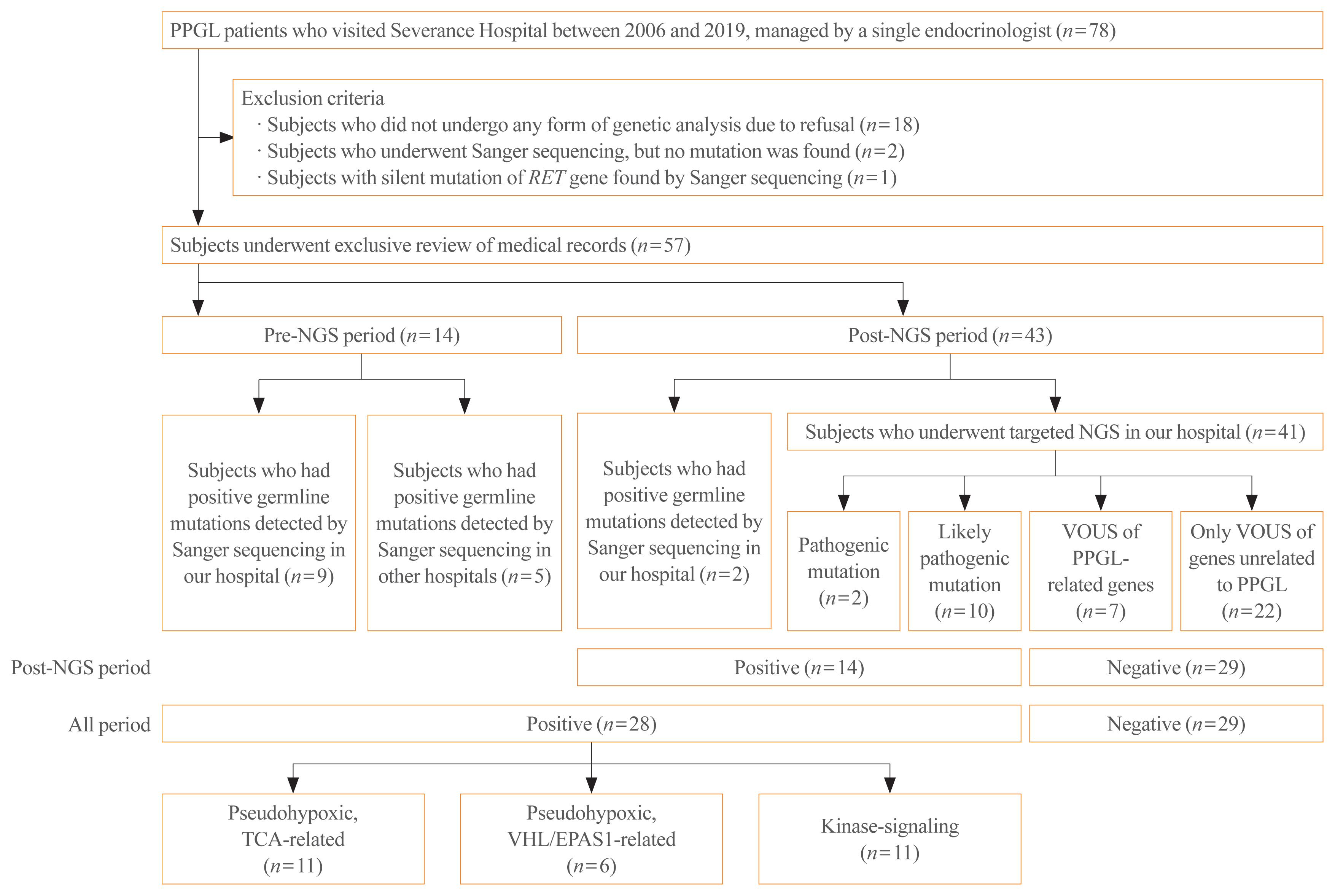
- 4,604 View
- 186 Download
- 8 Web of Science
- 8 Crossref
-
 Abstract
Abstract
 PDF
PDF Supplementary Material
Supplementary Material PubReader
PubReader  ePub
ePub - Background
Pheochromocytoma and paragangliomas (PPGL) are hereditary in approximately 30% to 40% cases. With the advancement of genetic analysis techniques, including next-generation sequencing (NGS), there were attempts to classify PPGL into molecular clusters. With NGS being applied to clinical settings recently, we aimed to review the results of genetic analysis, including NGS, and investigate the association with clinical characteristics in Korean PPGL patients.
Methods
We reviewed the medical records of PPGL patients who visited Severance hospital from 2006 to 2019. We documented the clinical phenotype of those who underwent targeted NGS or had known germline mutations of related genes.
Results
Among 57 PPGL patients, we found 28 pathogenic germline mutations of susceptibility genes. Before the targeted NGS was implemented, only obvious syndromic feature lead to the Sanger sequencing for the specific genes. Therefore, for the exact prevalence, only patients after the year 2017, when targeted NGS was added, were included (n=43). The positive germline mutations were found in 14 patients; thus, the incidence rate is 32.6%. Patients with germline mutations had a higher likelihood of family history. There were significant differences in the type of PPGLs, percentage of family history, metastasis rate, presence of other tumors, and biochemical profile among three molecular clusters: pseudohypoxic tricarboxylic acid cycle-related, pseudohypoxic von Hippel-Lindau (VHL)/endothelial PAS domain-containing protein 1-related, and kinase-signaling group. Germline mutations were identified in seven PPGL-related genes (SDHB, RET, VHL, NF1, MAX, SDHA, and SDHD).
Conclusion
We report the expected prevalence of germline mutations in Korean PPGL patients. NGS is a useful and accessible tool for genetic analysis in patients with PPGLs, and further research on molecular classification is needed for precise management. -
Citations
Citations to this article as recorded by- Patient Sex and Origin Influence Distribution of Driver Genes and Clinical Presentation of Paraganglioma
Susan Richter, Nicole Bechmann
Journal of the Endocrine Society.2024;[Epub] CrossRef - Novel and recurrent genetic variants of VHL, SDHB, and RET genes in Chinese pheochromocytoma and paraganglioma patients
Chong Li, Jingyi Li, Chao Han, Ting Wang, Lixia Zhang, Zhifang Wang, Tingting Wang, Lijun Xu, Guangzhao Qi, Guijun Qin, Xialian Li, Lili Zheng
Frontiers in Genetics.2023;[Epub] CrossRef - Genetic Study in Pheochromocytoma: Is It Possible to Stratify the Risk of Hereditary Pheochromocytoma?
Marta Araujo-Castro, César Mínguez Ojeda, Iñigo García Sanz, Maria Calatayud, Felicia Hanzu, Mireia Mora, Almudena Vicente, Concepción Blanco Carrera, Paz de Miguel Novoa, María del Carmen López García, Cristina Lamas, Laura Manjón-Miguélez, María del Cas
Neuroendocrinology.2023; 113(6): 657. CrossRef - The Role of VHL in the Development of von Hippel-Lindau Disease and Erythrocytosis
Petra Hudler, Mojca Urbancic
Genes.2022; 13(2): 362. CrossRef - Bilateral Pheochromocytoma with Germline MAX Variant without Family History
Shinnosuke Hata, Mai Asano, Hiroyuki Tominaga, Masahide Hamaguchi, Fumiya Hongo, Takeshi Usui, Eiichi Konishi, Michiaki Fukui
Clinics and Practice.2022; 12(3): 299. CrossRef - Diagnosis for Pheochromocytoma and Paraganglioma: A Joint Position Statement of the Korean Pheochromocytoma and Paraganglioma Task Force
Eu Jeong Ku, Kyoung Jin Kim, Jung Hee Kim, Mi Kyung Kim, Chang Ho Ahn, Kyung Ae Lee, Seung Hun Lee, You-Bin Lee, Kyeong Hye Park, Yun Mi Choi, Namki Hong, A Ram Hong, Sang-Wook Kang, Byung Kwan Park, Moon-Woo Seong, Myungshin Kim, Kyeong Cheon Jung, Chan
Endocrinology and Metabolism.2021; 36(2): 322. CrossRef - Prevalence of Germline Variants in a Large Cohort of Japanese Patients with Pheochromocytoma and/or Paraganglioma
Masato Yonamine, Koichiro Wasano, Yuichi Aita, Takehito Sugasawa, Katsutoshi Takahashi, Yasushi Kawakami, Hitoshi Shimano, Hiroyuki Nishiyama, Hisato Hara, Mitsuhide Naruse, Takahiro Okamoto, Tadashi Matsuda, Shinji Kosugi, Kazuhiko Horiguchi, Akiyo Tanab
Cancers.2021; 13(16): 4014. CrossRef - Recurrent Germline Mutations of CHEK2 as a New Susceptibility Gene in Patients with Pheochromocytomas and Paragangliomas
Yinjie Gao, Chao Ling, Xiaosen Ma, Huiping Wang, Yunying Cui, Min Nie, Anli Tong, Dario De Biase
International Journal of Endocrinology.2021; 2021: 1. CrossRef
- Patient Sex and Origin Influence Distribution of Driver Genes and Clinical Presentation of Paraganglioma

- A Case of Focal Type Nesidioblastosis in Adult Treated with Distal Pancreatectomy.
- Dae Gyu Seo, Wang Sik Shin, Gil Sung Han, Jae Gun Jung, Ho Sang Shon, Ki Sung Ahn, Hoon Kyu Oh, Jae bok Park, Young Jin Kim
- J Korean Endocr Soc. 1994;10(2):136-141. Published online November 6, 2019
- 1,112 View
- 23 Download
-
 Abstract
Abstract
 PDF
PDF - Nesidioblastosis, the process of differentiation of pancreatic islets from ductular epithelium, is a frequent cause of hyperinsulinemic hypoglycemia in neonates and infants, but rare in adults. A 38-year-old man had suffered from intermittent hypoglycemic symtoms for 10 years. He had inappropriately elevated plasma immunoreactive insulin level and I/G ratio during a prolonged fast. There was no evidence of tumor on the abdominal CT scan and operation although celiac angiography showed a round mass like lesion in the distal pancreatic area.His hypoglycemic symptoms were improved by distal pancreatectomy.Pathologic finding in the resected pancreas was that of focal type nesidioblastosis I.e, increased size and number of islets with scattered numerous small islets around ductules in focal lesion. Distal pancreatectomy as an initial operation may be effective in the treatment of focal type nesidioblastosis.

- Clinical Study
- Excessive Iodine Status among School-Age Children in Korea: A First Report
- Young Sik Choi, Soyoung Ock, Sukyoung Kwon, Sang Bong Jung, Kwang-Hyuk Seok, Young Jin Kim, Bu Kyung Kim, Jee-Yeong Jeong
- Endocrinol Metab. 2017;32(3):370-374. Published online September 18, 2017
- DOI: https://doi.org/10.3803/EnM.2017.32.3.370
- 3,943 View
- 41 Download
- 4 Web of Science
- 5 Crossref
-
 Abstract
Abstract
 PDF
PDF PubReader
PubReader Background Korea is considered an iodine sufficient country, and several studies have been conducted regarding iodine status in healthy Korean adults, pregnant women, and preschool children. However, data on iodine status in Korean school-age children are lacking. Therefore, the iodine nutrition status of Korean school-age children was investigated by measuring urine iodine concentration (UIC).
Methods This cross-sectional study conducted between April and September 2016 comprised 373 school-age children. UIC was determined using a modified microplate method employing ammonium persulfate digestion followed by Sandell-Kolthoff reaction.
Results The median UIC was 458.2 µg/L. Excessive iodine intake (>300 µg/L) was found in 286 children (76.7%), with extremely high values exceeding 1,000 µg/L in 19.6% of subjects. Insufficient iodine intake (<100 µg/L) was observed in eight children (2.1%). UIC values were not significantly different between sexes.
Conclusion Korean school-age children showed excessive iodine intake. Therefore, education regarding adequate iodine intake in school-age children is needed.
-
Citations
Citations to this article as recorded by- Relationship of iodine excess with thyroid function in 6-year-old children living in an iodine-replete area
Yun Jeong Lee, Sun Wook Cho, Youn-Hee Lim, Bung-Nyun Kim, Johanna Inhyang Kim, Yun-Chul Hong, Young Joo Park, Choong Ho Shin, Young Ah Lee
Frontiers in Endocrinology.2023;[Epub] CrossRef - Excessive iodine status among school‐aged children in the State of Qatar: Results of the National Iodine Deficiency Disorder Survey
Mohamed Hamad J. T. Al‐Thani, Salah Abdulla Sh. A. Alyafei, Kholoud Ateeq K. M. Al‐Motawaa, Shamseldin Ali Khalifa, Syed Hassan Bin Usman Shah, Benjamin Vinodson, Sureshbabu Kokku, Amit Mishra
Public Health Challenges.2023;[Epub] CrossRef - Changing Iodine Status and the Incidence of Thyroid Disease in Mainland China: A Prospective 20-Year Follow-Up Study
Zhongyan Shan, Yushu Li, Yongze Li, Haoyu Wang, Di Teng, Xiaochun Teng, Wei Chong, Xiaoguang Shi, Jing Li, Jiahui Guo, Zhe Lou, Chenling Fan, Shuangning Ding, Li He, Hua Liu, Elizabeth N. Pearce, Weiping Teng
Thyroid®.2023; 33(7): 858. CrossRef - Association between urinary sodium levels and iodine status in Korea
Jonghwa Ahn, Jang Ho Lee, Jiwoo Lee, Ji Yeon Baek, Eyun Song, Hye-Seon Oh, Mijin Kim, Suyeon Park, Min Ji Jeon, Tae Yong Kim, Won Bae Kim, Young Kee Shong, Won Gu Kim
The Korean Journal of Internal Medicine.2020; 35(2): 392. CrossRef - Effects of Maternal Iodine Status during Pregnancy and Lactation on Maternal Thyroid Function and Offspring Growth and Development: A Prospective Study Protocol for the Ideal Breast Milk Cohort
Young Ah Lee, Sun Wook Cho, Ho Kyung Sung, Kyungsik Kim, Young Shin Song, Sin Je Moon, Jung Won Oh, Dal Lae Ju, Sooyeon Choi, Sang Hoon Song, Gi Jeong Cheon, Young Joo Park, Choong Ho Shin, Sue K. Park, Jong Kwan Jun, June-Key Chung
Endocrinology and Metabolism.2018; 33(3): 395. CrossRef
- Relationship of iodine excess with thyroid function in 6-year-old children living in an iodine-replete area

- Thyroid
- A Rare Manifestation of Hypothyroid Myopathy: Hoffmann's Syndrome
- Kang Won Lee, Sun Hwa Kim, Kyoung Jin Kim, Sang Hyun Kim, Hee Young Kim, Byung-Jo Kim, Sin Gon Kim, Dong Seop Choi
- Endocrinol Metab. 2015;30(4):626-630. Published online December 31, 2015
- DOI: https://doi.org/10.3803/EnM.2015.30.4.626
- 6,385 View
- 88 Download
- 9 Web of Science
- 6 Crossref
-
 Abstract
Abstract
 PDF
PDF PubReader
PubReader Hypothyroid myopathy is observed frequently and the resolution of the clinical manifestations of myopathy following thyroid hormone replacement is well known. However, a specific subtype of hypothyroid myopathy, Hoffmann's syndrome, characterized by increased muscular mass (pseudohypertrophy), proximal muscle weakness, muscle stiffness and cramps, is rarely reported. Herein, we describe a 34-year-old male who presented with proximal muscle weakness and non-pitting edema of the lower extremities. He initially visited the neurology department where he was suspected of having polymyositis. Additional laboratory evaluation revealed profound autoimmune hypothyroidism and elevated muscle enzymes including creatine kinase. The patient was started on levothyroxine treatment and, subsequently, clinical symptoms and biochemical parameters resolved with the treatment. The present case highlights that hypothyroidism should be considered in the differential diagnosis of musculoskeletal symptoms even in the absence of overt manifestations of hypothyroidism. To our knowledge, this is the first case reported in Korea.
-
Citations
Citations to this article as recorded by- Hoffmann’s syndrome in the differential work-up of myopathic complaints: a case report
Sabine Winter, Bianka Heiling, Niklas Eckardt, Christof Kloos, Hubertus Axer
Journal of Medical Case Reports.2023;[Epub] CrossRef - Hypothyroidism: A Peculiar Presentation
Rita V Nogueira, Rui Lima, Carina Parente, Pedro Liberal, Lucia Santos
Cureus.2023;[Epub] CrossRef - Hoffman's syndrome as the presenting manifestation of non-primary hypothyroidism in a case of Prader-Willi Syndrome
R. Ghosh, A. Ray, D. Roy, J. Benito-Leon
Neurología.2022; 37(9): 824. CrossRef - Hoffman's syndrome as the presenting manifestation of non-primary hypothyroidism in a case of Prader-Willi Syndrome
R. Ghosh, A. Ray, D. Roy, J. Benito-Leon
Neurología (English Edition).2022; 37(9): 824. CrossRef - Hoffmann’s syndrome necessitating forearm fasciotomy: a case report
Erling Aarsæther, Ragnar Joakimsen, Hanne Halvorsen, Trude Sildnes, Olav Sivertsen, Jan Due
Journal of Medical Case Reports.2020;[Epub] CrossRef - Hypothyroid myopathy: A peculiar clinical presentation of thyroid failure. Review of the literature
Alessandro Sindoni, Carmelo Rodolico, Maria Angela Pappalardo, Simona Portaro, Salvatore Benvenga
Reviews in Endocrine and Metabolic Disorders.2016; 17(4): 499. CrossRef
- Hoffmann’s syndrome in the differential work-up of myopathic complaints: a case report

- Primary Hyperparathyroidism with Extensive Brown Tumors and Multiple Fractures in a 20-Year-Old Woman
- Ju Hee Choi, Kyoung Jin Kim, Ye Jin Lee, Sun Hwa Kim, Sin Gon Kim, Kwang Yoon Jung, Dong Seop Choi, Nam Hoon Kim
- Endocrinol Metab. 2015;30(4):614-619. Published online December 31, 2015
- DOI: https://doi.org/10.3803/EnM.2015.30.4.614
- 4,004 View
- 47 Download
- 5 Web of Science
- 4 Crossref
-
 Abstract
Abstract
 PDF
PDF PubReader
PubReader A brown tumor is a benign fibrotic, erosive bony lesion caused by localized, rapid osteoclastic turnover, resulting from hyperparathyroidism. Although brown tumors are one of the most pathognomonic signs of primary hyperparathyroidism, they are rarely seen in clinical practice. In this report, we present a case of 20-year-old woman with recurrent fractures and bone pain. Plain digital radiographs of the affected bones revealed multiple erosive bone tumors, which were finally diagnosed as brown tumors associated with primary hyperparathyroidism due to a parathyroid adenoma. This case shows that multiple, and clinically severe form of brown tumors can even occur in young patients.
-
Citations
Citations to this article as recorded by- Brown tumor of the knee as the first presentation of primary hyperparathyroidism caused by parathyroid adenoma: A case report
Vaishnavi C Tapadia, Romana Riyaz, Abhigan Babu Shrestha, Javeed Akhtar Ankolvi
Radiology Case Reports.2023; 18(5): 1852. CrossRef - Brown tumors in nuclear medicine: a systematic review
Nicolas Jacquet-Francillon, Nathalie Prevot
Annals of Nuclear Medicine.2023; 37(5): 255. CrossRef - Misdiagnosis of brown tumour caused by primary hyperparathyroidism: a case report with literature review
Yanchun Zhong, Yuxi Huang, Jiaquan Luo, Yongjun Ye
BMC Endocrine Disorders.2022;[Epub] CrossRef - Gnathic Bones and Hyperparathyroidism: A Review on the Metabolic Bony Changes Affecting the Mandible and Maxilla in case of Hyperparathyroidism
Hazim Mahmoud Ibrahem
Advances in Medicine.2020; 2020: 1. CrossRef
- Brown tumor of the knee as the first presentation of primary hyperparathyroidism caused by parathyroid adenoma: A case report


 KES
KES

 First
First Prev
Prev



